|
GREETINGS FROM OUR SOLAR POWERED OFFICE!
Spring hours starting April - October!
8am - 4:30pm MST
~~~~~~~~~~~~~~~
NEWS LETTER INDEX:
~~~~~~~~~~~~~~~
|
|
20KW SOLAR ARRAY AT THE BUTTE BREWING
COMPANY! Stop in for a cold, PV-powered beer!
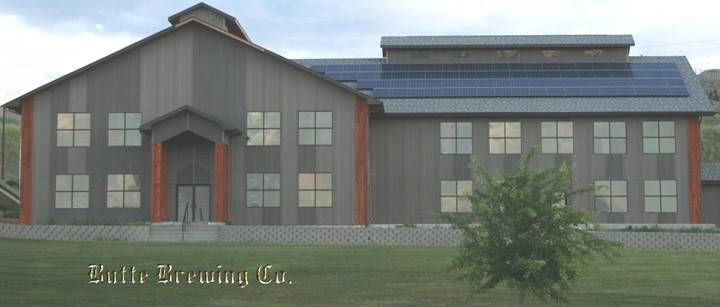
The Butte
Brewing Company is located at 465 East Galena Street, Butte, MT
(uptown Butte). It is the dream-child of Tony Olsen, who started
this project in 2012. The solar array consists of eighty 250W
REC Peak Energy Series (REC250PE) solar modules; the silicon
ingots are made in Butte, MT and the modules themselves are
manufactured in Singapore. The grid-tied inverters are Fronius
IG Plus 10.0, ten kilowatt inverters suitable for commercial or
larger residential systems.
Tony
became infatuated with the idea of a brewery back in 2005; he
and a buddy (from the Montana National Guard) visited another
brewery in Helena, and he was smitten with the big tanks,
equipment and great beer, so he decided that a brewery in a
‘green’ building was his goal. Tony Olsen likes being
self-reliant as much as possible, so it was only natural to put
a photovoltaic system on his new building—which also includes
super-insulated concrete forms and an in-floor radiant heating
system. His brewery building also has office space above as well
as a large 2500 sq. ft. conference room that is available for
rent. The actual building project got underway in 2012, and
Tony’s been brewing beer since last fall. The taproom will open
officially by June 1st, 2015.
Tony
Olsen was able to get Northwestern Energy and REAP grants, and
of course the federal tax credit for this project. He says he
did get smacked with a significant state tax hit upon
completion, but other than that, he’s been extremely happy with
his project—and is still thrilled when he sees his electrical
meter spinning backwards.
Two years ago the building was still under construction, but as
soon as the roof
was finished, Oasis Montana installed the solar
array.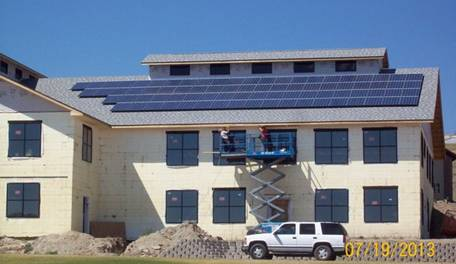
Butte
Brewing Company’s goal is to have 20 brews on tap; right now
they are brewing the following: honey cream ale, sweet stout,
pale ale (with Nelson Sauvin hops), porter, IPA, red ale and
hefeweizen. They’ll be officially pouring on or before June 1st!
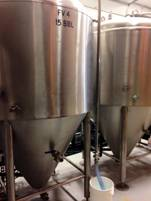
~~~~~~~~~~~~~~~
|
The solar
tax credit is scheduled to end at the end of 2016 for
residential and commercial properties…. This is a 30%
federal investment tax credit for solar energy systems. It’s
a tax policy that has played a vital role in creating good,
American jobs, lowering energy bills for consumers,
increasing U.S. global competitiveness, energy security, and
reducing pollution from fossil-fuel based energy sources.
The company or person that installs, develops or pays for
the power project uses the credit (a homeowner applies it to
his/her income taxes). This Investment Tax Credit (ITC) has
been one of the most important federal programs to support
the development of solar power in the U.S.; it has driven an
amazing job growth sector, with over 20% growth per annum —
the fastest employment growth of any industry in our
country! The solar industry now employs more than either the
steel or coal industries in the U.S.
So if you are considering the purchase of a solar power system,
get your equipment together before the end of next year. It
would be helpful to also ask your legislators to extend the ITC
further, and continue the growth of the solar industries; as
time goes on, component efficiencies have increased and costs
for consumers continue to go down. Unfortunately, there is no
clear consensus among legislators that the expiration date should
be extended.
We at Oasis Montana feel that our fledgling solar industry will
survive the expiration of the tax credit, if that comes about —
but we also feel it is unfair to continue to massively subsidize
other energy sectors at the same time! A gradual reduction of the
solar tax credit would be a good idea — but only AFTER we cut the
more than $4B/year in fossil fuel tax incentives. One would think
after 100 years of production the fossil fuel industry would be
mature enough and could exist without the tax incentives...especially
considering they are the most profitable corporations in the world.
To see what incentives you may qualify for, visit
www.dsireusa.org;
incentives vary from state to state, and some utilities may offer grants
in your particular area.
SOLAR MODULE PRICING—Call for availability, freight costs, and quantities
(# of modules) on pallets for the best deal. You can’t get less than
a pallet quantity to get the pallet ‘deal.’ For larger modules,
pallet quantity generally runs between 20 and 56 modules, and often
there are significant additional charges for less (or more) than
even pallet quantities. Some suppliers charge re-boxing fees too.
Single/ Pallet
LG280
Neon 280W, 9.07A,
31.4V (64.57” X 39.37”) $439 $407
(27
per pallet)
Made
in South Korea
PHONOSOLAR,
PS260M, .93A, 240VAC (64.6” x 39.1”) $529 $489 (18 per pallet)
Made
in China, monocrystalline AC module with Enphase Microinverters
TRINA
TSM-PD14/305,
305W, 8.25A, 33.3V (77” x 39.05”) $349 $323
(24
per pallet)
Made
in China; multicrystalline
SILFAB
SLA-270, 270W,
31.2V, 8.56A (38.97” x 64.96”) $359 $334
(35
per pallet)
ARRA
Compliant
SOLARWORLD SW280, 280W, 7.25A, 28.4V (39.4” x 65.94”) $420 $389
(30
per pallet) Made in the USA or
Germany; monocrystalline
CANADIAN SOLAR, 255W, 30.1V, 8.4A (64.5” x 38.7”) $329 $315 (24
per pallet)
Made
in China; polycrystalline
PHONOSOLAR
PS260M
260W, 30.8V, 8.46A (64.6” x 39”) $369 $339
(24
per pallet)
Made
in China; monocrystalline
PHONOSOLAR
PS290P,
290W, 8.03A, 36.1V (65” x 39.1”) $409 $399
(22
per pallet)
Made
in Taiwan & eastern Europe; polycrystalline
SUNIVA 270W, 31.2V, 8.6A (38.66” x 65.07”) $389 $352 (25
per pallet)
Buy
American Compliant—cells made in the U.S., assembled in China
KYOCERA 245GX,
245W, 8.23A, 29.8V (64.5” x 39”) $379 $359
(20
per pallet)
KYOCERA 140GX,
140W, 7.91A, 17.7V (59.1” x 26.3”) $319 $299
(20
per pallet)
Made
in Japan or Mexico. Kyocera has a re-boxing fee for odd-numbered
module shipments.(Some Kyocera
modules may have a 2-3 month lead time)
KYOCERA
KS20, 20W,
16.9V, 1.20 A (20.47” X 13.85”) $169 $158
(40+
per pallet)
KYOCERA
KS10, 10W,
16.9V, 0.60A (11.96” X 13.85”) $113 $110
(40+
per pallet)
KYOCERA
KS5, 5W,
16.9V, 0.29A (8.07” X 13.85”) $84 $74
(40+
per pallet)
Other modules
generally available too—prices subject to change with little notice.
Call for
your
module pricing and availability.
Container pricing available for better dollar-per-watt cost. There
have been some price increases this year, so costs may change
without notice.
WHO WE ARE and ORDERING INFORMATION:
Chris
Daum, owner and manager of Oasis Montana, has been in
the renewable energy field since 1989, and our system
designer, Larry Keogh, will help plan a power or pumping
system for your needs. Our staff offers experience,
personalized service, tech support, quality components
and good pricing . We are happy to work with your
installer, electrician, or contractor, and locally we
can install your power system (in western MT and Idaho).
We provide detailed wiring diagrams with the systems we
sell.
TO PLACE AN ORDER:
E-mail or call us for your freight costs; if you have any questions about
your system or product, please contact us. E-mail is
easiest and fastest (but we know that you aren’t all on
line). We accept
Visa/Mastercard
(personal and business checks are fine). For our
international customers, we accept bank transfers—
e-mail or call us for our banking information. Our
summer hours (April through October) are 8:00 am to 4:30
pm Mountain Time, Mon. – Thurs, 8 to 4 on Fridays. If
we‘re on another line when you call,
please leave us a message, and we’ll
get back to you as soon as we can, but you may have to
leave a message if we’re with a customer or on one of
the other lines.
406-777-4321 or 4309
or e-mail
us at info@oasismontana.com
for tech support
on renewable energy systems, freight costs and general
inquiries. We’d be very happy to help you with your
power project — send an e-mail or give us a call!
~~~~~~~~~~~~~~~ |
|
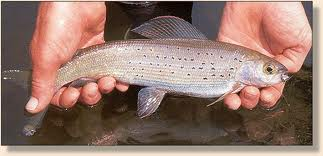 Arctic grayling struggle on the Big Hole River in Montana:
“Montana grayling have been lost from the vast majority of the
rivers and streams where they once swam, and they desperately need
the protections of the Endangered Species Act to survive,” said Noah
Greenwald, endangered species director at the Center for Biological
Diversity. “The U.S. Fish and Wildlife's most recent decision to
deny the grayling protection is dirty politics that doesn't follow
the science. Twenty years is too long to wait for protection.” The
Service first determined the grayling warranted endangered status in
1994 and reaffirmed that conclusion in 2010, but reversed course in
August 2014 withholding protection from the rare and beautiful
relative of trout and salmon. In denying the grayling protection,
the agency argued that voluntary efforts by private landowners and
the state of Montana, guided by a conservation agreement in place
since 2006, have alleviated threats to the fish's survival. Although
many individual projects to improve habitat have been completed
under the agreement, the grayling continues to face numerous
threats, including excessive water withdrawals for irrigation,
non-native trout and ongoing habitat degradation. A member of the
salmon family, the Arctic grayling is a beautiful fish with a
prominent dorsal fin. The species thrives in cold freshwater streams
and rivers across Canada and Alaska. Historically, fluvial
populations of Arctic grayling existed in only two places in the
lower 48 states: Michigan and the upper Missouri River of Montana.
Populations in Michigan went extinct by the 1930s, and populations
in Montana were restricted to the Big Hole River and a few lakes by
the end of the 1970s. Studies demonstrate that Montana grayling are
genetically distinct from populations in Canada and Alaska, and have
been experiencing severe declines in response to the near drying-up
of the Big Hole River on an annual basis caused by increased
irrigation use and greater extremes of drought. The following is a
story of how ranchers, a solar pumping system, our local FWP and
other agencies are trying to protect the last of this unique fish’s
Montana habitat. Click here for more information:
http://www.pvsolarpumps.com/pumpaeration.htm Arctic grayling struggle on the Big Hole River in Montana:
“Montana grayling have been lost from the vast majority of the
rivers and streams where they once swam, and they desperately need
the protections of the Endangered Species Act to survive,” said Noah
Greenwald, endangered species director at the Center for Biological
Diversity. “The U.S. Fish and Wildlife's most recent decision to
deny the grayling protection is dirty politics that doesn't follow
the science. Twenty years is too long to wait for protection.” The
Service first determined the grayling warranted endangered status in
1994 and reaffirmed that conclusion in 2010, but reversed course in
August 2014 withholding protection from the rare and beautiful
relative of trout and salmon. In denying the grayling protection,
the agency argued that voluntary efforts by private landowners and
the state of Montana, guided by a conservation agreement in place
since 2006, have alleviated threats to the fish's survival. Although
many individual projects to improve habitat have been completed
under the agreement, the grayling continues to face numerous
threats, including excessive water withdrawals for irrigation,
non-native trout and ongoing habitat degradation. A member of the
salmon family, the Arctic grayling is a beautiful fish with a
prominent dorsal fin. The species thrives in cold freshwater streams
and rivers across Canada and Alaska. Historically, fluvial
populations of Arctic grayling existed in only two places in the
lower 48 states: Michigan and the upper Missouri River of Montana.
Populations in Michigan went extinct by the 1930s, and populations
in Montana were restricted to the Big Hole River and a few lakes by
the end of the 1970s. Studies demonstrate that Montana grayling are
genetically distinct from populations in Canada and Alaska, and have
been experiencing severe declines in response to the near drying-up
of the Big Hole River on an annual basis caused by increased
irrigation use and greater extremes of drought. The following is a
story of how ranchers, a solar pumping system, our local FWP and
other agencies are trying to protect the last of this unique fish’s
Montana habitat. Click here for more information:
http://www.pvsolarpumps.com/pumpaeration.htm
|
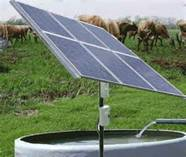 Whether you need water moved for your creek, your
pool, your off-grid home, for irrigation, pond aeration or for
your livestock, we can help provide your water pumping solution.
Visit us now online at
www.PVsolarpumps.com
— fill out the
questionnaire and we’ll propose a system for your project. And
while we offer several different kinds of pumps, you can view a
neat video from one of our suppliers at
https://www.youtube.com/watch?v=2HTn0hINh98 Whether you need water moved for your creek, your
pool, your off-grid home, for irrigation, pond aeration or for
your livestock, we can help provide your water pumping solution.
Visit us now online at
www.PVsolarpumps.com
— fill out the
questionnaire and we’ll propose a system for your project. And
while we offer several different kinds of pumps, you can view a
neat video from one of our suppliers at
https://www.youtube.com/watch?v=2HTn0hINh98
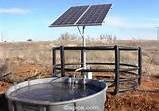 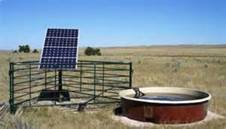 WHEN THE POWER GOES OUT….how can I
keep my water pump operating in an emergency situation? We’ve
been hearing this question on a regular basis. As utility
infrastructure ages, and severe weather becomes the new norm,
people are concerned about having water available if the power
fails. Unfortunately, the answer isn’t always easy or cheap. If
your power is pretty dependable and your outages short, your
best bet may be a fuel generator; you can have your electrician
wire the individual pump circuit or get the properly sized
generator to power your entire home, and install a transfer
switch. If you are interested in a solar-powered system, it will
be considerably more expensive but will feed back power. Most
people’s well pumps are AC, which means you need an inverter
system that’ll handle the starting surge of that motor, as well
as operate the pump for as long as you need water. While many
people in the world are very happy to have 5 to 7 gallons per
day, the average American uses 50 to 75 gallons per day — and
some use much more. Even if your water usage is modest, you will
still need to be able to power that pump. For a 3/4HP system:
 1 -
Outback Flexpower Dual GVFX3648 Inverter system, which
includes two inverters, FM80 charge controllers, system
monitor and integration equipment, surge protect- tor,
battery and PV breakers 1 -
Outback Flexpower Dual GVFX3648 Inverter system, which
includes two inverters, FM80 charge controllers, system
monitor and integration equipment, surge protect- tor,
battery and PV breakers
16 -
Surrette S-480 6V Deep Cycle batteries
24 -
Q-Cell 255W 60 cell Solar Modules
2 -
12X Top of Pole Mounting Racks for solar modules
1 -
Battery Box vent fan
PLUS the balance of system
components including battery cables, hardware, disconnects,
combiner enclosures, panel output cables, grounding
fittings, surge protectors (but not including installation,
shipping or battery box)
Well, folks, we are looking right around $30,000 for just
the equipment for a system to be able to run your 3/4 HP
water pump. Now in addition to being able to power this
pump, when not being used in an emergency situation, this
system will feed power back to your utility. Your
electricity provider needs to have a net metering plan in
place before you can even consider having a system like this
(the GVFX inverters are designed to feed power back once the
batteries are full in the morning). So you will be able to
reduce (or, if you are efficient, negate) your utility bill
with this grid-tie system.
Here at the Oasis Montana home/office, we have a system
very similar to this, only we are utilizing an Outback
Radian inverter and 27 Sanyo solar modules — and yes folks,
it did cost upwards of $30K. But, you would still be able to
take advantage of the 30% federal tax credit, plus whatever
state incentives are available where you live. 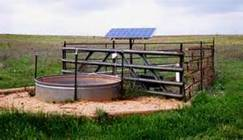
We are looking
at different 'soft start' technologies that can
use a smaller (and hence cheaper) inverter
set-up to be able to run a water pump in the
absence of AC power. Call or e-mail us for more
options.
~~~~~~~~~~~~~~~
|
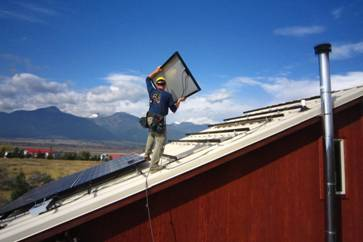
Hey DIYers — do you know how to handle a solar
module? While solar modules are usually made from
tempered or hardened glass, and can generally tolerate
the same conditions as your car windshield, it’s
possible that rough handling can cause ‘micro-fractures’
which can cause degradation of the solar cells many
years before its time (solar cell substrates are
delicate). If you think about hauling a (basically)
framed piece of glass onto a mount structure or a roof,
there is evidence to indicate that resting it on your
shoulder when you climb a ladder, or leaning heavily on
it when you are attaching it to the mounting racks can
indeed have a long-term effect on its longevity and
performance. So whether you are a solar professional or
a do-it-yourselfer installing your own solar modules for
your home or business, get another person on the other end of
the frame, and handle it with care. Make sure your
mounting structures are rated for and give adequate
support in high winds or under extreme snow loads —
which can also cause micro-fractures. Ultimately, too,
not all solar modules are created equal. Some of the
cheap deals can have thinner glass & frames, or be of
poorer construction which can contribute to a shorter
electrical lifespan.
If a solar panel has been dropped or stepped on, it may
appear to be fine and still operate at full output. But
it has likely suffered from micro-fractures which will
ultimately result in reduced output. We rate the useful
lifespan of a solar module at 30 to 40 years (and most
we sell have a 20 to 25 year output warranty). Still,
they should be installed carefully to get the most bang
for your bucks—and good longevity. Here’s a video about
micro-fractures, and how NOT to clean your solar
modules:
http://www.purepowerengineering.com/how-not-to-clean-pv-modules/ (beware: eye-candy alert!)
~~~~~~~~~~~~~~~
|
|
|
Something new is blowing
in the wind….our popular 200W CHINOOK Wind Turbines were
discontinued a while back, but a redesigned model is in the
works, and we are hoping it will be available by the beginning
of next year (2016). The new beast will be a 500W model, and
will be available as a 12, 24 or 48V battery charging unit—or
for a grid-tie system with no batteries. The Chinook folks are
in corroboration with Midnite Solar, so the new wind genny will
undoubtedly come with its own controller (if as a battery
charging model) or a grid-tie inverter will be specified if you
don’t want to mess with batteries.
Another wind turbine from Midnite is in the works, the ARMY WIND
generator; it’s a one kilowatt model (1000 watts top end); it’ll
be tough as nails and will also be available for 12, 24, 48V
battery charging or as a grid-tie unit. We really don’t have
much information for these at this point; they are in the
testing phase. As soon as these become available we will be
offering them. Stay tuned for more information!
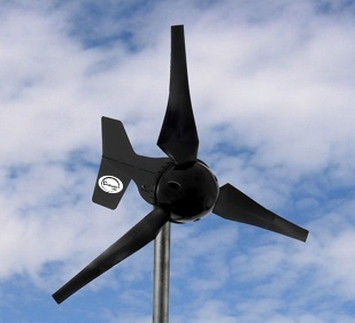
|
|
~~~~~~~~~~~~~~~ |
New
Consolidated Appliance Website
If you are interested in
efficient or gas appliances, we’ve listened to you and have
developed a new site with oodles of information:
http://www.eco-fridge.com/allappliances/Index.html We
offer several Energy Star rated refrigerators with European
styling, gas fridges and stoves for your remote cabin and even
DC models to efficiently run off your battery bank. Visit our
site today!

Note: Appliances are not
stocked locally and ship from our suppliers back east. |
|
~~~~~~~~~~~~~~~ |
|

Crystal Ball Gazing
We get calls asking
about trends in our industry. Based on our “insider”
knowledge and sources,
we would like to share some of the trends we see as having
an impact plus some of the, at present, “pie in the sky”
notions you may have heard of or are wondering about.
Energy Storage (batteries):
All
batteries are a form of storing energy and the primary focus
of late has been on enhancing “energy density”. FLA (Flooded
lead acid), AGM (Absorbed Glass Mat) and Gel cell batteries
are the most commonly used batteries for storing energy
generated by alternative energies and represent the best
investment today. A major
focus of the renewable energy industry now is energy
storage; here are a few of the leading
contenders for alternative energy storage devices.
LiOn (Lithium Ion) batteries are becoming more main stream with
the advent of Electric Vehicles. Though progress has been
made in creating a safer (less prone to melt down) battery,
there remains room for improvement. These have proven very
reliable and are an effective means of storing energy for
use in our phone and tablet devices, but their charging perimeters for power
systems are very specific and there are still bugs to be
worked out for integration into RE power systems.
Li-air (Lithium Air)
much of the current
research is focused on four different chemical designs. The
aprotic design is
see the most focus at present. The other three design
technologies; aqueous,
mixed aqueous/aprotic
and solid state all
face distinct advantages and significant technical
challenges.
There has been a lot
of money invested in coming up with an innovative energy
storage device and we suspect there will be more in the near
future. Our “Crystal Ball” gazing reveals that the next
evolution will come from tinkerers working from a garage
somewhere. They typically will have as a goal some personal
desire to improve an aspect of their
own lives and a new
application of existing technology will likely create the
next major boost in development.
KAir (Potassium Air)
in Oct 2014 Ohio State
University announced the introduction of a potassium air
battery that achieves 98% energy efficiency. We’ll have to
wait and see if this product comes to market.
NiFe (Nickel-iron)
nickel-iron batteries are
also known as “Edison Battery” and have an extended life
extending well beyond the rated 20 year life. The slow
charge rate coupled with slow discharge rate make them an
undesirable solution for all but a limited number of
applications for renewable energies.
|
|
~~~~~~~~~~~~~~~ |
KEEP YOUR COOL WITH THESE HIGH
QUALITY ATTIC FANS
Unlike AC fans, these
well-made Solaro Aire™ units won’t use a penny of your
electricity. During summer months, your attic can get up to
160°F, making your home miserably hot. Solaro Aire™ fans
extract the heat from your attic, keeping temperatures and
air conditioning bills down. These fans run ‘array direct’;
when the sun shines, they are running, and during the
hottest part of the day is when they are moving the most
air. These are a terrific replacement for noisy turbine-type
vents.
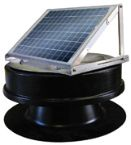 The SA-20WT-LPE, left, has a 20W
solar module and moves up to 950 CFM., with an polymer fan
blade and brushless motor; its cost before shipping is $820. The model, right,
SA-20WB-LPE The SA-20WT-LPE, left, has a 20W
solar module and moves up to 950 CFM., with an polymer fan
blade and brushless motor; its cost before shipping is $820. The model, right,
SA-20WB-LPE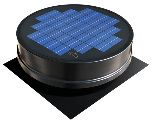 is a
low profile style fan, great for composite and shingle roofs
($743 before shipping). At lower left is the SA-20WR-LPE, which offers a model where the solar module
can be mounted remotely (if the sun access in the desired
fan location is in the shade). This model is $799
before shipping; you can also get a larger solar module if
needed, in case you have shading issues where the fan is
placed. Higher profile fans are available where additional
clearances
(SA-20WT-LPE, above)
are needed; gable mounted fans for
ventilation are also available. Factory is a
low profile style fan, great for composite and shingle roofs
($743 before shipping). At lower left is the SA-20WR-LPE, which offers a model where the solar module
can be mounted remotely (if the sun access in the desired
fan location is in the shade). This model is $799
before shipping; you can also get a larger solar module if
needed, in case you have shading issues where the fan is
placed. Higher profile fans are available where additional
clearances
(SA-20WT-LPE, above)
are needed; gable mounted fans for
ventilation are also available. Factory
installed
thermostats are available ($59), so the fans will only
operate when the temperature is
above (SA-20WB-LPE,
above) 85°F. These fans can also be used in
winter months to remove mold and mildew-causing moisture.
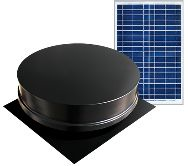 We can send you installation links
for these fans, something your contractor or handyperson can
do. And these also qualify for the 30% solar tax credit
through 2020 (cost
of the fan plus installation). These come with a limited
lifetime warranty from the manufacturer; and built with
aircraft aluminum specs, they are meant to last a lifetime,
with weather resistant powder coated housing providing a
durable finish. If you are interested in these fine fans,
send us an e-mail today and we will send additional
information.
info@oasismontana.com We can send you installation links
for these fans, something your contractor or handyperson can
do. And these also qualify for the 30% solar tax credit
through 2020 (cost
of the fan plus installation). These come with a limited
lifetime warranty from the manufacturer; and built with
aircraft aluminum specs, they are meant to last a lifetime,
with weather resistant powder coated housing providing a
durable finish. If you are interested in these fine fans,
send us an e-mail today and we will send additional
information.
info@oasismontana.com
(SA-20WR-LPE, above)
|
|
~~~~~~~~~~~~~~~ |
You can become an energy detective with
your Killawatt™ Meter!
If you are trying to keep a lid on your electric bill, it’s most
helpful to determine what your electrical loads are on certain
devices. Is your refrigerator really an energy hog? How much more
juice does your PC use than your laptop? This device is a simple way
to determine your electrical usage. You plug it into a wall socket
(or perhaps onto an extension cord, to make it easier to read) and
plug your appliance or device into it. It will give you
instantaneous readings on voltage, watts, amps, and frequency
(hertz) numbers. It also gives you cumulative data—so you can see
how much power your ‘fridge pulls in a week. If you plug your
refrigerator into it, it should cycle and give a higher figure from
time to time—that means your compressor is running then. These are
still a great deal at $25 plus shipping!
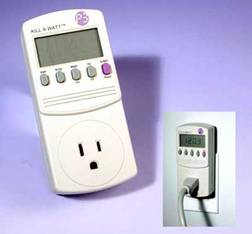
~~~~~~~~~~~~~~~
RENEWABLE ENERGY NEWS BITES:
States That Produce Renewable
Energy Have Cheaper Electricity:
http://www.onearth.org/earthwire/renewable-energy-prices A study released by the
venture capitalist firm DBL Investors shows that states boasting
robust green energy programs have the nation’s cheapest electricity.
The trend lines suggest it’s only going to get better for their
consumers. In 2001, electricity cost more in the 10 top renewable
energy states than it did in the 10 states with the lowest
proportion of green energy production. By 2013, the situation had
turned upside down: States with the most green energy now offer
cheap electricity, while the dirty power states are the most
expensive. The 10 states with cheap green energy are Maine, Iowa,
South Dakota, California, Idaho, Kansas, Minnesota, North Dakota,
and Oklahoma, plus Washington, DC. The 10 laggard states in the DBL
study were Florida, Connecticut, Delaware, South Carolina, West
Virginia, Rhode Island, Ohio, Missouri, Tennessee, and Kentucky.
Cow poop makes more than a mess in the NE: http://www.greenmountainpower.com/innovative/cow/how-it-works/ Good bio-digester info.
New Tesla Battery Will Power a Home and Maybe the Electric Grid Too:
http://www.washingtonpost.com/blogs/the-switch/wp/2015/02/12/this-new-tesla-battery-will-power-your-home-and-maybe-the-electric-grid-too.
Tesla is working on a battery that can power a home and even help large-scale utilities store energy more efficiently, according to company
chief executive Elon Musk. If Tesla's stationary battery takes off, it could change the way electricity is priced and traded on a market scale.
Musk said the designs for a home or business battery are already complete and will likely be unveiled to the public "in the next month or two."
Production could be as little as six months away, he added. "We are trying to figure out what would be a cool stationary (battery) pack,"
Musk said. "Some will be like the Model S pack: something flat, 5 inches off the wall, wall-mounted, with a beautiful cover, an integrated
bi-directional inverter, and plug and play." There's no word yet on price.
Solar PV Will Be Cheapest Form of Power Within a Decade: http://cleantechnica.com/2015/02/25/solar-pv-will-cheapest-form-power-within-decade/?
A major new study from a leading German think tank and renewable energy specialist says the cost reduction potential of large scale solar
is still misunderstood, and predicts that solar PV will be the cheapest form of power within a decade, and cost less than $0.02/kWh by 2050.
The study by the Berlin-based Agora Energiewende says that the end to cost reductions from solar plants is “not in sight”, even after falling
more than 70 per cent in recent years. The balance of systems costs are expected to fall by up to 2/3 in coming decades, and combined with a
fall in the cost of finance, could cut the cost of solar technology in areas such as the U.S., Australia, and parts of Europe.
Clean Coal and our future: http://exp.grist.org/clean-coal Take a few moments and check out
this informative article about one of our least clean fossil fuels, its cost, consequences, corporate interests and benefits.
The real future threat: peak water.
http://www.theguardian.com/global-development/2013/jul/06/water-supplies-shrinking-threat-to-food
With burgeoning population and more water going to extract gas and petroleum, just how much water do we have to lose?
Will solar plunge off the tax credit cliff?
http://www.renewableenergyworld.com/rea/news/article/2015/02/will-solar-plunge-off-the-tax-credit-cliff?cmpid=WNL-Wednesday-February25-2015
The solar tax credit will expire at the end of 2016. Will we preserve this job-creator?
States should fuel
community solar growth:
http://www.renewableenergyworld.com/rea/news/article/2015/03/three-steps-states-can-take-to-fuel-community-solar-growth?cmpid=SolarNL-Tuesday-March17-2015
Making light on remote
reservations:
http://www.upworthy.com/shes-going-door-to-door-with-light-and-older-navajos-have-never-seen-anything-like-it?c=upw1
A
very cool 'small hydro' idea increases efficiency and
makes power:
http://www.businessenergy.net/DE/Blogs/2191.aspx
There is solar, and there is solar:
http://www.renewableenergyworld.com/rea/news/article/2015/01/there-is-solar-and-there-is-solar?cmpid=WNL-Wednesday-January28-2015
A day in the life of a
wind farm operator:
http://www.renewableenergyworld.com/rea/news/article/2015/01/photoessay-a-day-in-the-life-of-a-wind-farm-operator?cmpid=WNL-Wednesday-January28-2015
15
ancient house designs you can build for cheap:
http://offgridquest.com/973
Turning fecal sludge to black gold:
http://www.renewableenergyworld.com/rea/news/article/2015/02/how-the-chinese-are-turning-fecal-sludge-into-black-gold?cmpid=WNL-Wednesday-February4-2015
Solar powered water wheel cleans 25 tons of trash a day.....
http://billmoyers.com/2014/07/22/solar-powered-water-wheel-can-clean-50000-pounds-of-baltimore%E2%80%99s-trash-per-day/
~~~~~~~~~~~~~~~
Quotable quotes:
“When the winds of change blow, some people build walls and others
build windmills.” —Chinese proverb
- - - -
"When all the world appears to be in a tumult, and nature itself is
feeling the assault of climate change, the seasons retain their
essential rhythm. Yes, fall gives us a premonition of winter, but
then, winter, will be forced to
relent, once again, to the new beginnings of soft greens, longer
light, and the sweet air of spring." — Madeleine M. Kunin
- - - -
"Behold, my friends, the spring is come; the earth has gladly
received the embraces of the sun, and we shall soon see the results
of their love!" ——Sitting Bull
- - - -
“"One of the great dreams of man must be to find some place between
the extremes of nature and civilization where it is possible to live
without regret." --Barry Lope
- - - -
“What a strange thing! to be alive beneath cherry blossoms.” --
Kobayashi Issa
- - - -
“Summer afternoon—summer afternoon; to me those have always been the
two most beautiful words in the English language.” ― Henry James
- - - -
“The first week of August hangs at the very top of summer, the top
of the live-long year, like the highest seat of a Ferris wheel when
it pauses in its turning. The weeks that come before are only a
climb from balmy spring, and those that follow a drop to the chill
of autumn, but the first week of August is motionless, and hot. It
is curiously silent, too, with blank white dawns and glaring noons,
and sunsets smeared with too much color.” ― Natalie Babbett
- - - -
“Wood burns faster when you have to cut and chop it yourself.”
—Harrison Ford
- - - -
“Lawyers believe a person is innocent until proven broke.” —Robin
Hall
You have received this newsletter as you have indicated a
previous interest in renewable energy and/or efficient appliances.
If you have received this in error, we apologize; ours is a small,
hand-maintained list. To be removed simply hit 'reply' with REMOVE
in the subject line.
~~~~~~~~~~~~~~~
|
|
Thank you for your
interest in Oasis Montana. For more information go to
http://www.oasismontana.com/, send
us an email at info@oasismontana.com, or call us
at 406-777-4321or 4309.
And feel free to share this newsletter with your friends; knowledge is
POWER!
|
| |
|
